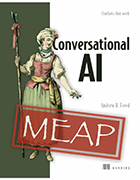The 3 types of chatbots for beginners and how to build them
Various types of chatbots exist, but three types, in particular, are easiest for beginners to learn and build independently. Find out more in this chapter excerpt.
While software engineering skills can benefit technology professionals looking to build chatbots for the first time, the process keeps getting easier.
The deeper, more technical parts of the process remain the same: classifiers, dialogues, variations, intents and more, yet many modern tools for chatbot builders feature low-code and no-code environments. However, the best way to learn about creating chatbots is to go out and build one, said author Andrew Freed. His book Conversational AI from Manning Publications walks through this process, as well as the types of chatbots readers can make and the training and testing processes.
Below is an excerpt from Chapter 2, "Building your first virtual assistant," which provides a universal, fictional example for building a chatbot from scratch. Freed takes an imaginary company that readers can place themselves and their workplaces into as they read, to make the example -- including the benefits and challenges -- more relatable. The chapter tells readers how they can build the best chatbot to help their organizations, pick out its questions and answers, and what types of chatbots readers can create.
For someone building a chatbot for the first time, Freed recommended three types of chatbots to learn first. Those types are the following:
- A simple question and answer, or FAQ, bot. With these chatbots, the user asks a question, the bot answers, and that's it. This type of chatbot was popular at the start of the COVID-19 pandemic to answer people's questions about the pandemic. FAQ chatbots have minimal interaction and are more like a Google search, Freed said.
- A customized question and answer bot. With this type of chatbot, the questions don't always have the same answer. The chatbot can provide a personalized response based on what it knows about users, such as how they came in or their locations. This type of chatbot is slightly more advanced than a simple FAQ bot but is still a basic back-and-forth format.
- A more advanced chatbot that can complete actions and requests. For example, readers could create a chatbot that integrates into an existing system and resets users' passwords upon request. This type of chatbot involves multiple parts, where it asks for the user's ID, security question or other authentication methods, then actively resets the password for the user. This chatbot involves more software work in the middle, Freed said, but it still follows the basic format.
Explore Conversational AI
Click here to read Chapter 2, "Building your first virtual assistant."
Organizations embrace chatbots to save money, get answers to users faster and improve customers' experiences. As the industry continues to grow and more methods of building chatbots pop up, this technology will become more accessible for those who want to learn it.








